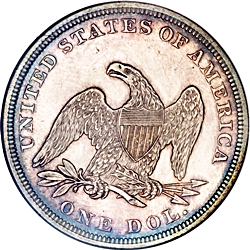 |
1861
 

|
 |
General Comments
1861 can be compared to years in the late 1850ís Ė mintage indicates ready availability, but experience
indicates otherwise. 1861 coins are scarce to rare in any grade. Despite a mintage ranking of 31st out
of 46, examples are more difficult to locate than either 1859 or 1860. That said, this date is probably
less underrated than the two mentioned above. The market has done a better job of recognizing its rarity.
Most authors believe that the export of dollars was reduced by 1861. Itís likely that many were melted
within our borders, simply because their silver content was several percent over their face value. Another
factor that affects value should not be underestimated Ė the demand by collectors of Civil War memorabilia.
This single factor probably doubles the demand for this and the other Civil War dates.
|
| |||||||||||||||||||||
1861 examples are usually well struck. Some will have very slight softness on the star centrals, but all other obverse details are usually above average. Reverses are almost always sharp, although some examples will show a slight lack of definition on the upper edge of the eagleís left wing. High-grade business strikes are often prooflike or semi-prooflike. With a low mintage and 4 different die pairs the dies didnít get a chance to wear off their initial prooflike surfaces.
1861 Die Marriages
6 die marriages have been positively identified. Four obverse dies were each paired with a different reverse die to strike business strikes. All business strike die marriages are scarce, the most common rated R3+. None of the business strike dies were used for proofs. A single obverse die was paired with two different reverses to produce two proof die marriages. Breen identifies a third proof die marriage, but we have not been able to confirm its existence. We suspect that it was an early state of one of the business strike die marriages. We should note that the first edition of our book identified the second proof reverse die as Reverse 1861 PB. Since that time John Pack of Stacks-Bowers identified a proof of 1861 which paired the known proof obverse with 1856 Reverse PA. A review of our research confirmed that the die that we had identified as 1861 Reverse PB was actually 1856 Reverse PA. This web site and our to-be-published Second Edition now reflect this change. Our thanks to John for being observant enough to correctly identify the second 1861 proof reverse.
We should note that itís very possible that additional die pairings exist. The 1861 reverse dies are difficult to attribute, almost impossible when only a photo is available. We could have missed identifying a new die pair simply because we were unable to differentiate the reverse dies.
Click the links below to view the details of each die marriage.
Die Marriage |
Rarity |
Obverse Die |
Reverse Die |
Estimated Survivors |
| OC-1 | R5+ | 1 | A | 45 |
| OC-2 | R3+ | 2 | B | 265 |
| OC-3 | R6- | 3 | C | 30 |
| OC-4 | R4- | 4 | D | 160 |
| OC-P1 | R4+ | P1 | PA | 110 |
| OC-P2 | R4 | P1 | 1856 PA | 140 |
1861 Business Strike Emission Sequence
Since there is no overlap of business strike dies the emission sequence can't be determined. If
additional die marriages are discovered which share any of these dies weíll update the emission
sequence.
Emission Order |
Die Marriage |
Comments |
| 1 | OC-1 | |
| 2 | OC-2 | |
| 3 | OC-3 | |
| 4 | OC-4 |
1861 Proof Emission Sequence
We believe that the extent of die polish on Obverse P1 indicates that the sequence
listed below is correct. However, the differences are minute, and open to interpretation. Suffice it
to say that we took our best shot.
Emission Order |
Die Marriage |
Comments |
| 1 | OC-P1 | |
| 2 | OC-P2 | Reduction of the unfinished area under the chin indicates that OC-P2 followed OC-P1. |
1861 Quick Finder Chart
Attribution of 1861 die marriages can be difficult. See our comments in the 1861 Die Marriage section above.
Neither the obverse nor reverse dies display major markers. Date positions are different enough to allow
attribution, but the differences are minor, so care must be taken. The following table lists the keys for
identifying each variety.
Die Marriage |
Obv Die |
Rev Die |
Right |
Keys |
| OC-1 | 1 | A | LE | Obverse: Vertically centered date.
Reverse: A light die line slants down to the right in the upper right corner of the 7th shield recess. |
| OC-2 | 2 | B | RE | Obverse: Date slants VS down. A tiny lump at the base of the unfinished area under the chin.
Reverse: A tiny lump at the top of the branch just left of the left claw. |
| OC-3 | 3 | C | JL of C | Obverse: 1st 1 is JL of C and slightly low. 2nd 1 is centered.
Reverse: No notable markers. |
| OC-4 | 4 | D | JL of C | Obverse: Low date. Faint die lines from the denticles below the heel.
Reverse: No notable markers. |
| OC-P1 | P1 | PA | B | Obverse: Very low date.
Reverse: Slightly unfinished between the leaves. |
| OC-P2 | P1 | 1856 PA | B | Obverse: Very low date.
Reverse: Die rust lumps on the L in DOL and the first S in STATES. |
| Photo credits:
Obverse and reverse full photos: 1861 NGC MS65, ex. Quellar, from the Heritage archives. |
